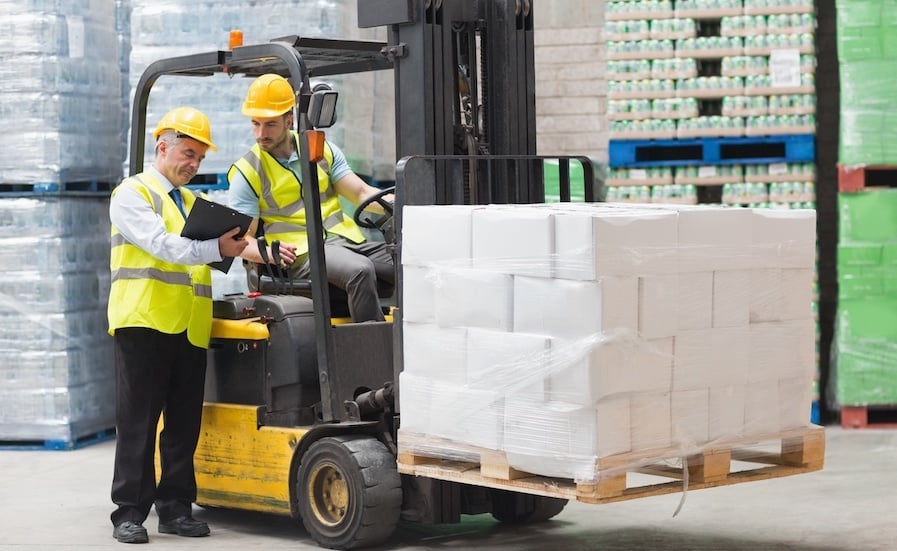
Achieving true efficiency in your operational workflows requires two important components: reliable data and a means of control. If you’re treating your vehicle usage in and around the warehouse as a simple, untracked resource, you’re actually missing out on an opportunity to capture both of those components at the same time.
Gleaning actionable data from your existing vehicle fleet is simple when you have a properly-implemented vehicle management system or VMS.
What is a VMS?
A vehicle management system is a term that encompasses smart, forward-thinking usage and tracking of all fleet movements. Consider this: you likely have your employees sign into work using separate logins or identification cards, and you might even extend that personal accountability to handheld tools, such as barcode scanners.
 If you’re already implementing that level of accountability in a day’s work, leaving vehicles in a catch-as-catch-can system doesn’t make much sense. A VMS gives you a transparent view of metrics by turning each vehicle into a data node, complete with login capabilities.
If you’re already implementing that level of accountability in a day’s work, leaving vehicles in a catch-as-catch-can system doesn’t make much sense. A VMS gives you a transparent view of metrics by turning each vehicle into a data node, complete with login capabilities.
In its most common form, a VMS would appear as a card or badge reader integrated into a vehicle’s dash or door. An operator would need to swipe or scan their badge to enter the vehicle or power-on the ignition, even if keys were available. It only adds a few more seconds to the act of taking a work vehicle, but a smart employer gets the benefit of peace of mind as well as rich data from which to make planning decisions.
How a VMS Can Help Your Operation
A comprehensive VMS rollout acts as the answer to a variety of questions — ones that usually plague an operation’s bottom line. You’ll not only know when and if your operators are driving safely within your stated parameters, but you’ll also be able to gauge productivity based on vehicle movement.
You’ll be able to quickly discover if your fleet is under or over-developed, highlighting where you’ll need to supplement with manpower or trim away excess for financial success.
Depending on your company insurance policy, implementing a VMS may also have a beneficial effect on your premium: “lockout” style badge scan-ins reduce the temptation for theft and outside vandalism.
VMS Benefits
Safety
While you might have standing rules against it, improperly-trained employees may operate a vehicle they aren’t licensed to in a time crunch situation. They may justify the use at the moment — a trained employee wasn’t available, it was just one quick product pick, etc. — but the result is the same: liability. If they hurt themselves or others operating machinery they shouldn’t be, you’re placed in a potentially damaging situation as an employer. Adding a VMS would ensure that no unauthorized employees will be using your equipment.
Compliance
These “rogue” employees may not cause any physical damage, but that doesn’t mean they can’t damage your business standing with oversight groups like OSHA. Violations are not only costly, they trigger additional disruptive spot checks during future follow-ups. Employees will continue to operate vehicles out of their scope of work if there’s nothing preventing them from doing so. This remains an ever-present risk as official walk-through audits by outside agencies are typically unannounced.
Resource Protection
Once more, even if an unlicensed operator doesn’t hurt themselves or others, they are untrained and a risk to your equipment. If they operate or adjust the vehicle incorrectly, they may cause damage to tires, control arms, or even surrounding warehousing racks. Even a “dinged” bumper can shift the undercarriage of smaller warehouse or logistics vehicles, compromising load stability the next time it’s used.
Metric Management
In addition to finding out where, when, and how your employees are performing their vehicle-related tasks, the metrics provided by a VMS help you optimize. You’ll be able to pinpoint exactly how long a task takes — 3 minutes to pick a SKU, 2 minutes to walk it to the packing table, and so on — and use this data to extrapolate how long larger shipments will take to process completely.
Operational Fleet Optimization
Find out if you’re using the resources at your company’s disposal to their best advantage. Not only will a VMS allow you to keep tabs on what your employees are using company vehicles for, but it will also help highlight equipment that isn’t being used to its full potential. Perhaps most importantly, you will be able to better track vehicle maintenance and tune-ups, resulting in less downtime and expensive repairs.
Real Time Results of a VMS
The benefits of vehicle management systems are many, reaching from B2C to B2B businesses, and even government operations. Whether it’s boosting pallet movement YOY, reducing fleet maintenance expenses, or freezing equipment buys and upgrades out of lack of necessity, a VMS gives you greater visibility and power over your supply chain.
Of the metric systems available to a modern business, a VMS is fairly painless and very easy to attach to a current fleet of vehicles. It lets managers stay where they belong: in control and completely up-to-date on all fleet movements.
To Sum It Up
A VMS is absolutely crucial to boosting productivity, safety in the workplace, and bigger bottom lines for stakeholders. If you’d like to discover more about this powerful, proactive approach to logistics, we invite you to download our ebook, “Why You Should Choose Kenco Material Handling Systems” — in it, you’ll find everything you need to know to keep your supply chain agile, safe, and competitive.
